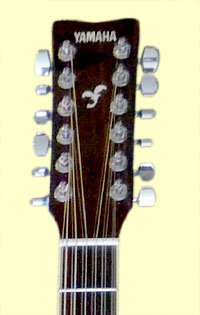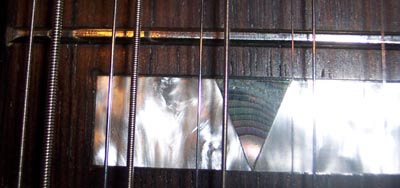Twelve String
The first time most people see a 12-string guitar, they can
tell there is something wrong. Something seems off. It simply doesn't look
quite right to the eye. The neck is too wide. The headstock is too long.
There are too many tuning machines and there are all those strings. That's
the problem. There are too many strings. Why are there so many strings?

That question is answered the first time you hear a 12-string
guitar being played by someone who loves all those strings, the too-fat
neck and the giant headstock with too many tuning machines. The sound of
a 12-string guitar is magic. People use words such as full, loud, harmonious,
beautiful and glorious to describe the sound only a 12-string guitar can
make. It has no equal in the world of guitars and as far as anyone knows,
no one has built a 14-string guitar yet!

The history of the 12-string guitar is shrouded in folklore. There are whispered
tales of Italian luthiers working in dimly lit factories in Chicago and
New York for companies such as Harmony, Supro and Oscar Schmidt.
There are stories of odd-looking guitars coming from Mexico into Texas.
This theory is very plausible as Mexican guitars have a long history of
instruments with double course strings. One example is the guitarron. There
are also theories about harp guitars and lutes being the inspiration for
the 12-string guitar.
Whilst its origins remain a mystery, the Grunewald Company in New Orleans
featured a 12-string guitar in their 1904 catalogue and described it as
a new invention. Lyon and Healy were next, in 1905, with a "Mexican
Style" 12-string guitar. Many guitar players considered it a novelty
instrument and it remained largely obscure until the 1930s.
It was in 1927 that bluesman, Blind Willie McTell started
playing a 12-string Stella and he is probably most responsible for the instrument's
longevity. It seems that from the 1930s onwards, every generation had its
share of 12-string guitar players that kept the instrument alive, if not
widely popular. The aforementioned Willie McTell dominated the blues in
the 1930s. The 1940s gave rise to Huddie "Leadbelly" Ledbetter
who carried the 12-string guitar blues into the 1950s. Pete Seeger took
up the 12-string guitar in the 1950s and his music caused an explosion of
12-string popularity in the 1960s that carried through to the 1970s.
In the 1960s, rock and roll found the 12-string guitar, or perhaps the 12-string
guitar found rock and roll. Either way, they made history together. From
the start, rock and roll was guitar driven, loud and different. Perhaps
the mindset that prevailed was "if six strings is loud and cool, twelve
strings is louder and cooler". The list of artists and bands that used
12-string guitars during that era is an impressive one. The Who, The Yardbirds,
The Rolling Stones and Bob Dylan are but a few. The Byrds classic "Eight
Miles High" heavily features the Rickenbacker electric 12 string.

The 12-string guitar shows up on songs such as Led Zeppelin's
"Stairway to Heaven", David Bowie's "Space Oddity" and
America's "Horse with No Name". Everyone from the Beatles to Jimi
Hendrix has quietly (or not so quietly) slipped a 12-string guitar into
their music. During this era, the 12-string guitar made its way into every
genre of popular music with the exception, perhaps, of disco. But it wouldn't
be surprising to find the 12-string guitar there either. This is a tribute
to the expressiveness of the instrument and the creativity of those who
choose to play it.
Since the days of Led Zeppelin, the popularity of 12-string guitars has
waned in modern music and is largely restricted to enthusiasts and true
virtuosos, like Leo Kottke, who have kept the instrument alive through the
1990s.
Is the 12-string guitar relevant to music today? The answer to that question is a resounding yes! The diversity of bands using 12-string guitars is a testament to its relevance. Rock bands that have used 12-string guitars range from Pantera, The Eagles and Aerosmith to Pink Floyd and dozens of others. The 12-string guitar is also a favourite among country, folk and gospel bands. Unbelievably, there are even obscure references to 12-string guitar loops being used in techno and dance music. Oh my!

Jimmy Page with a Fender xii
One of the best examples of the modern use of a 12-string guitar is James
Hetfield playing one on Metallica's "Nothing Else Matters" which
is proof enough that the 12-string guitar is appropriate for any style or
genre of music one might think of.
Even with its long and complex history, there remains a mystique that surrounds
the 12-string guitar. It looks hard to play. All those extra strings can
seem overwhelming to the inexperienced player, but in reality, it is played
just like a regular guitar. With time and practice, any guitar player can
become very competent on a 12-string guitar and it has been said that learning
to play one forces you to become a better player.

When looking for a 12-string guitar to call your own, sound
quality is more important than price, but even for those on a budget the
foremost consideration should be comfort. A comfortable guitar is simply
more fun to play. The neck should be comfortable in your hands. The strings
should not cut your fingers when you press them down. The bottom line is
that if the guitar hurts to play it, you will not play it.

My own version of the rare Fender xii
Many companies offer 12-string guitars in many configurations
at many different price points. Fender, Gibson, Ovation, Taylor, Yamaha,
Guild and several other lesser known companies build 12-string guitars.
You can get them in acoustic, acoustic/electric or even full on electric
for those with a wild side.Burns even make an electric 12 stringer (they
call it a double-six) The "Apache"
with a tremolo arm!
If you love being creative and want something different, many players strongly
recommend the awesome sound of the 12-string guitars that can be found at
Dawsons
Music . You too could become a part of musical history.